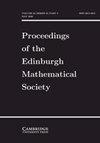Aleš Drápal, Ian M. Wanless
求助PDF
{"title":"二次拟群的同构","authors":"Aleš Drápal, Ian M. Wanless","doi":"10.1017/s0013091523000585","DOIUrl":null,"url":null,"abstract":"Let <jats:inline-formula> <jats:alternatives> <jats:inline-graphic xmlns:xlink=\"http://www.w3.org/1999/xlink\" mime-subtype=\"png\" mimetype=\"image\" xlink:href=\"S0013091523000585_inline1.png\" /> <jats:tex-math>$\\mathbb F$</jats:tex-math> </jats:alternatives> </jats:inline-formula> be a finite field of odd order and <jats:inline-formula> <jats:alternatives> <jats:inline-graphic xmlns:xlink=\"http://www.w3.org/1999/xlink\" mime-subtype=\"png\" mimetype=\"image\" xlink:href=\"S0013091523000585_inline2.png\" /> <jats:tex-math>$a,b\\in\\mathbb F\\setminus\\{0,1\\}$</jats:tex-math> </jats:alternatives> </jats:inline-formula> be such that <jats:inline-formula> <jats:alternatives> <jats:inline-graphic xmlns:xlink=\"http://www.w3.org/1999/xlink\" mime-subtype=\"png\" mimetype=\"image\" xlink:href=\"S0013091523000585_inline3.png\" /> <jats:tex-math>$\\chi(a) = \\chi(b)$</jats:tex-math> </jats:alternatives> </jats:inline-formula> and <jats:inline-formula> <jats:alternatives> <jats:inline-graphic xmlns:xlink=\"http://www.w3.org/1999/xlink\" mime-subtype=\"png\" mimetype=\"image\" xlink:href=\"S0013091523000585_inline4.png\" /> <jats:tex-math>$\\chi(1-a)=\\chi(1-b)$</jats:tex-math> </jats:alternatives> </jats:inline-formula>, where <jats:italic>χ</jats:italic> is the extended quadratic character on <jats:inline-formula> <jats:alternatives> <jats:inline-graphic xmlns:xlink=\"http://www.w3.org/1999/xlink\" mime-subtype=\"png\" mimetype=\"image\" xlink:href=\"S0013091523000585_inline5.png\" /> <jats:tex-math>$\\mathbb F$</jats:tex-math> </jats:alternatives> </jats:inline-formula>. Let <jats:inline-formula> <jats:alternatives> <jats:inline-graphic xmlns:xlink=\"http://www.w3.org/1999/xlink\" mime-subtype=\"png\" mimetype=\"image\" xlink:href=\"S0013091523000585_inline6.png\" /> <jats:tex-math>$Q_{a,b}$</jats:tex-math> </jats:alternatives> </jats:inline-formula> be the quasigroup over <jats:inline-formula> <jats:alternatives> <jats:inline-graphic xmlns:xlink=\"http://www.w3.org/1999/xlink\" mime-subtype=\"png\" mimetype=\"image\" xlink:href=\"S0013091523000585_inline7.png\" /> <jats:tex-math>$\\mathbb F$</jats:tex-math> </jats:alternatives> </jats:inline-formula> defined by <jats:inline-formula> <jats:alternatives> <jats:inline-graphic xmlns:xlink=\"http://www.w3.org/1999/xlink\" mime-subtype=\"png\" mimetype=\"image\" xlink:href=\"S0013091523000585_inline8.png\" /> <jats:tex-math>$(x,y)\\mapsto x+a(y-x)$</jats:tex-math> </jats:alternatives> </jats:inline-formula> if <jats:inline-formula> <jats:alternatives> <jats:inline-graphic xmlns:xlink=\"http://www.w3.org/1999/xlink\" mime-subtype=\"png\" mimetype=\"image\" xlink:href=\"S0013091523000585_inline9.png\" /> <jats:tex-math>$\\chi(y-x) \\geqslant 0$</jats:tex-math> </jats:alternatives> </jats:inline-formula>, and <jats:inline-formula> <jats:alternatives> <jats:inline-graphic xmlns:xlink=\"http://www.w3.org/1999/xlink\" mime-subtype=\"png\" mimetype=\"image\" xlink:href=\"S0013091523000585_inline10.png\" /> <jats:tex-math>$(x,y) \\mapsto x+b(y-x)$</jats:tex-math> </jats:alternatives> </jats:inline-formula> if <jats:inline-formula> <jats:alternatives> <jats:inline-graphic xmlns:xlink=\"http://www.w3.org/1999/xlink\" mime-subtype=\"png\" mimetype=\"image\" xlink:href=\"S0013091523000585_inline11.png\" /> <jats:tex-math>$\\chi(y-x) = -1$</jats:tex-math> </jats:alternatives> </jats:inline-formula>. We show that <jats:inline-formula> <jats:alternatives> <jats:inline-graphic xmlns:xlink=\"http://www.w3.org/1999/xlink\" mime-subtype=\"png\" mimetype=\"image\" xlink:href=\"S0013091523000585_inline12.png\" /> <jats:tex-math>$Q_{a,b} \\cong Q_{c,d}$</jats:tex-math> </jats:alternatives> </jats:inline-formula> if and only if <jats:inline-formula> <jats:alternatives> <jats:inline-graphic xmlns:xlink=\"http://www.w3.org/1999/xlink\" mime-subtype=\"png\" mimetype=\"image\" xlink:href=\"S0013091523000585_inline13.png\" /> <jats:tex-math>$\\{a,b\\} = \\{\\alpha(c),\\alpha(d)\\}$</jats:tex-math> </jats:alternatives> </jats:inline-formula> for some <jats:inline-formula> <jats:alternatives> <jats:inline-graphic xmlns:xlink=\"http://www.w3.org/1999/xlink\" mime-subtype=\"png\" mimetype=\"image\" xlink:href=\"S0013091523000585_inline14.png\" /> <jats:tex-math>$\\alpha\\in \\operatorname{Aut}(\\mathbb F)$</jats:tex-math> </jats:alternatives> </jats:inline-formula>. We also characterize <jats:inline-formula> <jats:alternatives> <jats:inline-graphic xmlns:xlink=\"http://www.w3.org/1999/xlink\" mime-subtype=\"png\" mimetype=\"image\" xlink:href=\"S0013091523000585_inline15.png\" /> <jats:tex-math>$\\operatorname{Aut}(Q_{a,b})$</jats:tex-math> </jats:alternatives> </jats:inline-formula> and exhibit further properties, including establishing when <jats:inline-formula> <jats:alternatives> <jats:inline-graphic xmlns:xlink=\"http://www.w3.org/1999/xlink\" mime-subtype=\"png\" mimetype=\"image\" xlink:href=\"S0013091523000585_inline16.png\" /> <jats:tex-math>$Q_{a,b}$</jats:tex-math> </jats:alternatives> </jats:inline-formula> is a Steiner quasigroup or is commutative, entropic, left or right distributive, flexible or semisymmetric. In proving our results, we also characterize the minimal subquasigroups of <jats:inline-formula> <jats:alternatives> <jats:inline-graphic xmlns:xlink=\"http://www.w3.org/1999/xlink\" mime-subtype=\"png\" mimetype=\"image\" xlink:href=\"S0013091523000585_inline17.png\" /> <jats:tex-math>$Q_{a,b}$</jats:tex-math> </jats:alternatives> </jats:inline-formula>.","PeriodicalId":20586,"journal":{"name":"Proceedings of the Edinburgh Mathematical Society","volume":"34 11-12","pages":""},"PeriodicalIF":0.7000,"publicationDate":"2023-11-24","publicationTypes":"Journal Article","fieldsOfStudy":null,"isOpenAccess":false,"openAccessPdf":"","citationCount":"3","resultStr":"{\"title\":\"Isomorphisms of quadratic quasigroups\",\"authors\":\"Aleš Drápal, Ian M. Wanless\",\"doi\":\"10.1017/s0013091523000585\",\"DOIUrl\":null,\"url\":null,\"abstract\":\"Let <jats:inline-formula> <jats:alternatives> <jats:inline-graphic xmlns:xlink=\\\"http://www.w3.org/1999/xlink\\\" mime-subtype=\\\"png\\\" mimetype=\\\"image\\\" xlink:href=\\\"S0013091523000585_inline1.png\\\" /> <jats:tex-math>$\\\\mathbb F$</jats:tex-math> </jats:alternatives> </jats:inline-formula> be a finite field of odd order and <jats:inline-formula> <jats:alternatives> <jats:inline-graphic xmlns:xlink=\\\"http://www.w3.org/1999/xlink\\\" mime-subtype=\\\"png\\\" mimetype=\\\"image\\\" xlink:href=\\\"S0013091523000585_inline2.png\\\" /> <jats:tex-math>$a,b\\\\in\\\\mathbb F\\\\setminus\\\\{0,1\\\\}$</jats:tex-math> </jats:alternatives> </jats:inline-formula> be such that <jats:inline-formula> <jats:alternatives> <jats:inline-graphic xmlns:xlink=\\\"http://www.w3.org/1999/xlink\\\" mime-subtype=\\\"png\\\" mimetype=\\\"image\\\" xlink:href=\\\"S0013091523000585_inline3.png\\\" /> <jats:tex-math>$\\\\chi(a) = \\\\chi(b)$</jats:tex-math> </jats:alternatives> </jats:inline-formula> and <jats:inline-formula> <jats:alternatives> <jats:inline-graphic xmlns:xlink=\\\"http://www.w3.org/1999/xlink\\\" mime-subtype=\\\"png\\\" mimetype=\\\"image\\\" xlink:href=\\\"S0013091523000585_inline4.png\\\" /> <jats:tex-math>$\\\\chi(1-a)=\\\\chi(1-b)$</jats:tex-math> </jats:alternatives> </jats:inline-formula>, where <jats:italic>χ</jats:italic> is the extended quadratic character on <jats:inline-formula> <jats:alternatives> <jats:inline-graphic xmlns:xlink=\\\"http://www.w3.org/1999/xlink\\\" mime-subtype=\\\"png\\\" mimetype=\\\"image\\\" xlink:href=\\\"S0013091523000585_inline5.png\\\" /> <jats:tex-math>$\\\\mathbb F$</jats:tex-math> </jats:alternatives> </jats:inline-formula>. Let <jats:inline-formula> <jats:alternatives> <jats:inline-graphic xmlns:xlink=\\\"http://www.w3.org/1999/xlink\\\" mime-subtype=\\\"png\\\" mimetype=\\\"image\\\" xlink:href=\\\"S0013091523000585_inline6.png\\\" /> <jats:tex-math>$Q_{a,b}$</jats:tex-math> </jats:alternatives> </jats:inline-formula> be the quasigroup over <jats:inline-formula> <jats:alternatives> <jats:inline-graphic xmlns:xlink=\\\"http://www.w3.org/1999/xlink\\\" mime-subtype=\\\"png\\\" mimetype=\\\"image\\\" xlink:href=\\\"S0013091523000585_inline7.png\\\" /> <jats:tex-math>$\\\\mathbb F$</jats:tex-math> </jats:alternatives> </jats:inline-formula> defined by <jats:inline-formula> <jats:alternatives> <jats:inline-graphic xmlns:xlink=\\\"http://www.w3.org/1999/xlink\\\" mime-subtype=\\\"png\\\" mimetype=\\\"image\\\" xlink:href=\\\"S0013091523000585_inline8.png\\\" /> <jats:tex-math>$(x,y)\\\\mapsto x+a(y-x)$</jats:tex-math> </jats:alternatives> </jats:inline-formula> if <jats:inline-formula> <jats:alternatives> <jats:inline-graphic xmlns:xlink=\\\"http://www.w3.org/1999/xlink\\\" mime-subtype=\\\"png\\\" mimetype=\\\"image\\\" xlink:href=\\\"S0013091523000585_inline9.png\\\" /> <jats:tex-math>$\\\\chi(y-x) \\\\geqslant 0$</jats:tex-math> </jats:alternatives> </jats:inline-formula>, and <jats:inline-formula> <jats:alternatives> <jats:inline-graphic xmlns:xlink=\\\"http://www.w3.org/1999/xlink\\\" mime-subtype=\\\"png\\\" mimetype=\\\"image\\\" xlink:href=\\\"S0013091523000585_inline10.png\\\" /> <jats:tex-math>$(x,y) \\\\mapsto x+b(y-x)$</jats:tex-math> </jats:alternatives> </jats:inline-formula> if <jats:inline-formula> <jats:alternatives> <jats:inline-graphic xmlns:xlink=\\\"http://www.w3.org/1999/xlink\\\" mime-subtype=\\\"png\\\" mimetype=\\\"image\\\" xlink:href=\\\"S0013091523000585_inline11.png\\\" /> <jats:tex-math>$\\\\chi(y-x) = -1$</jats:tex-math> </jats:alternatives> </jats:inline-formula>. We show that <jats:inline-formula> <jats:alternatives> <jats:inline-graphic xmlns:xlink=\\\"http://www.w3.org/1999/xlink\\\" mime-subtype=\\\"png\\\" mimetype=\\\"image\\\" xlink:href=\\\"S0013091523000585_inline12.png\\\" /> <jats:tex-math>$Q_{a,b} \\\\cong Q_{c,d}$</jats:tex-math> </jats:alternatives> </jats:inline-formula> if and only if <jats:inline-formula> <jats:alternatives> <jats:inline-graphic xmlns:xlink=\\\"http://www.w3.org/1999/xlink\\\" mime-subtype=\\\"png\\\" mimetype=\\\"image\\\" xlink:href=\\\"S0013091523000585_inline13.png\\\" /> <jats:tex-math>$\\\\{a,b\\\\} = \\\\{\\\\alpha(c),\\\\alpha(d)\\\\}$</jats:tex-math> </jats:alternatives> </jats:inline-formula> for some <jats:inline-formula> <jats:alternatives> <jats:inline-graphic xmlns:xlink=\\\"http://www.w3.org/1999/xlink\\\" mime-subtype=\\\"png\\\" mimetype=\\\"image\\\" xlink:href=\\\"S0013091523000585_inline14.png\\\" /> <jats:tex-math>$\\\\alpha\\\\in \\\\operatorname{Aut}(\\\\mathbb F)$</jats:tex-math> </jats:alternatives> </jats:inline-formula>. We also characterize <jats:inline-formula> <jats:alternatives> <jats:inline-graphic xmlns:xlink=\\\"http://www.w3.org/1999/xlink\\\" mime-subtype=\\\"png\\\" mimetype=\\\"image\\\" xlink:href=\\\"S0013091523000585_inline15.png\\\" /> <jats:tex-math>$\\\\operatorname{Aut}(Q_{a,b})$</jats:tex-math> </jats:alternatives> </jats:inline-formula> and exhibit further properties, including establishing when <jats:inline-formula> <jats:alternatives> <jats:inline-graphic xmlns:xlink=\\\"http://www.w3.org/1999/xlink\\\" mime-subtype=\\\"png\\\" mimetype=\\\"image\\\" xlink:href=\\\"S0013091523000585_inline16.png\\\" /> <jats:tex-math>$Q_{a,b}$</jats:tex-math> </jats:alternatives> </jats:inline-formula> is a Steiner quasigroup or is commutative, entropic, left or right distributive, flexible or semisymmetric. In proving our results, we also characterize the minimal subquasigroups of <jats:inline-formula> <jats:alternatives> <jats:inline-graphic xmlns:xlink=\\\"http://www.w3.org/1999/xlink\\\" mime-subtype=\\\"png\\\" mimetype=\\\"image\\\" xlink:href=\\\"S0013091523000585_inline17.png\\\" /> <jats:tex-math>$Q_{a,b}$</jats:tex-math> </jats:alternatives> </jats:inline-formula>.\",\"PeriodicalId\":20586,\"journal\":{\"name\":\"Proceedings of the Edinburgh Mathematical Society\",\"volume\":\"34 11-12\",\"pages\":\"\"},\"PeriodicalIF\":0.7000,\"publicationDate\":\"2023-11-24\",\"publicationTypes\":\"Journal Article\",\"fieldsOfStudy\":null,\"isOpenAccess\":false,\"openAccessPdf\":\"\",\"citationCount\":\"3\",\"resultStr\":null,\"platform\":\"Semanticscholar\",\"paperid\":null,\"PeriodicalName\":\"Proceedings of the Edinburgh Mathematical Society\",\"FirstCategoryId\":\"100\",\"ListUrlMain\":\"https://doi.org/10.1017/s0013091523000585\",\"RegionNum\":3,\"RegionCategory\":\"数学\",\"ArticlePicture\":[],\"TitleCN\":null,\"AbstractTextCN\":null,\"PMCID\":null,\"EPubDate\":\"\",\"PubModel\":\"\",\"JCR\":\"Q2\",\"JCRName\":\"MATHEMATICS\",\"Score\":null,\"Total\":0}","platform":"Semanticscholar","paperid":null,"PeriodicalName":"Proceedings of the Edinburgh Mathematical Society","FirstCategoryId":"100","ListUrlMain":"https://doi.org/10.1017/s0013091523000585","RegionNum":3,"RegionCategory":"数学","ArticlePicture":[],"TitleCN":null,"AbstractTextCN":null,"PMCID":null,"EPubDate":"","PubModel":"","JCR":"Q2","JCRName":"MATHEMATICS","Score":null,"Total":0}
引用次数: 3
引用
批量引用
摘要
设$\mathbb F$为奇阶有限域,且$a,b\in\mathbb F\setminus\{0,1\}$为$\chi(a) = \chi(b)$和$\chi(1-a)=\chi(1-b)$,其中χ为$\mathbb F$上的扩展二次元。设$Q_{a,b}$为$\mathbb F$上的准群,如果$\chi(y-x) \geqslant 0$定义为$(x,y)\mapsto x+a(y-x)$,如果$\chi(y-x) = -1$定义为$(x,y) \mapsto x+b(y-x)$。我们证明$Q_{a,b} \cong Q_{c,d}$当且仅当$\{a,b\} = \{\alpha(c),\alpha(d)\}$对于某些$\alpha\in \operatorname{Aut}(\mathbb F)$。我们还描述了$\operatorname{Aut}(Q_{a,b})$并展示了进一步的性质,包括确定$Q_{a,b}$是Steiner拟群还是交换的、熵的、左分配的或右分配的、柔性的或半对称的。为了证明我们的结果,我们也刻画了$Q_{a,b}$的最小子拟群。
本文章由计算机程序翻译,如有差异,请以英文原文为准。
Isomorphisms of quadratic quasigroups
Let $\mathbb F$ be a finite field of odd order and $a,b\in\mathbb F\setminus\{0,1\}$ be such that $\chi(a) = \chi(b)$ and $\chi(1-a)=\chi(1-b)$ , where χ is the extended quadratic character on $\mathbb F$ . Let $Q_{a,b}$ be the quasigroup over $\mathbb F$ defined by $(x,y)\mapsto x+a(y-x)$ if $\chi(y-x) \geqslant 0$ , and $(x,y) \mapsto x+b(y-x)$ if $\chi(y-x) = -1$ . We show that $Q_{a,b} \cong Q_{c,d}$ if and only if $\{a,b\} = \{\alpha(c),\alpha(d)\}$ for some $\alpha\in \operatorname{Aut}(\mathbb F)$ . We also characterize $\operatorname{Aut}(Q_{a,b})$ and exhibit further properties, including establishing when $Q_{a,b}$ is a Steiner quasigroup or is commutative, entropic, left or right distributive, flexible or semisymmetric. In proving our results, we also characterize the minimal subquasigroups of $Q_{a,b}$ .

 求助内容:
求助内容: 应助结果提醒方式:
应助结果提醒方式:


